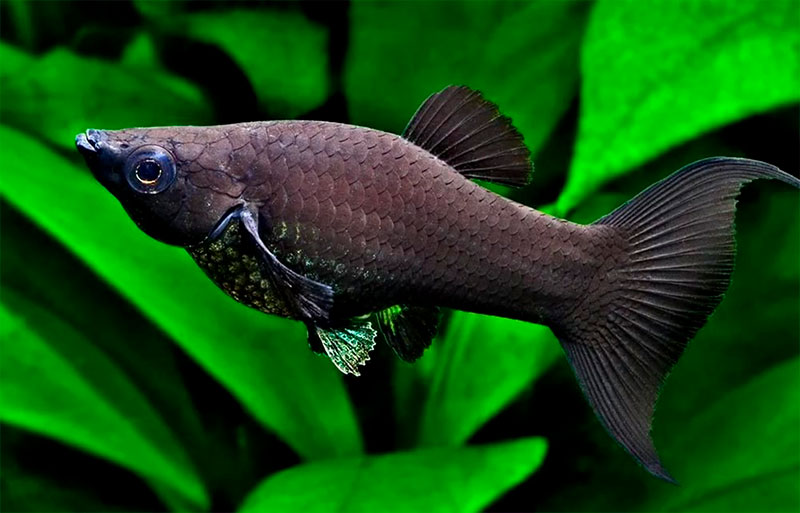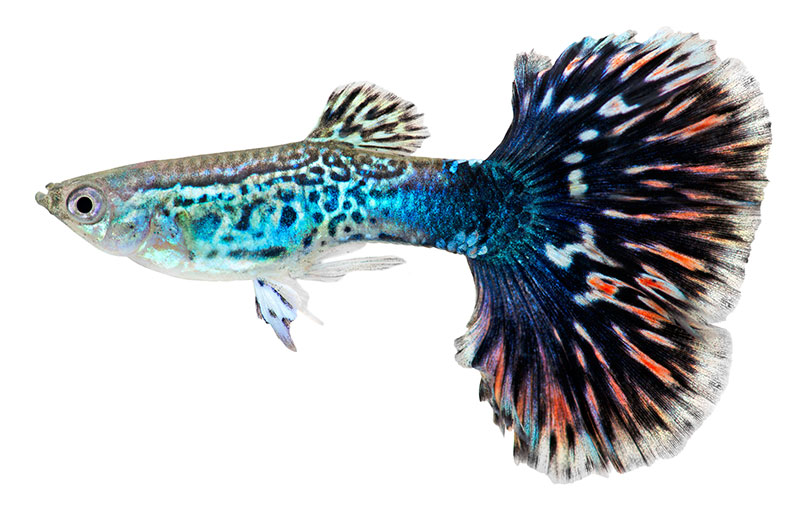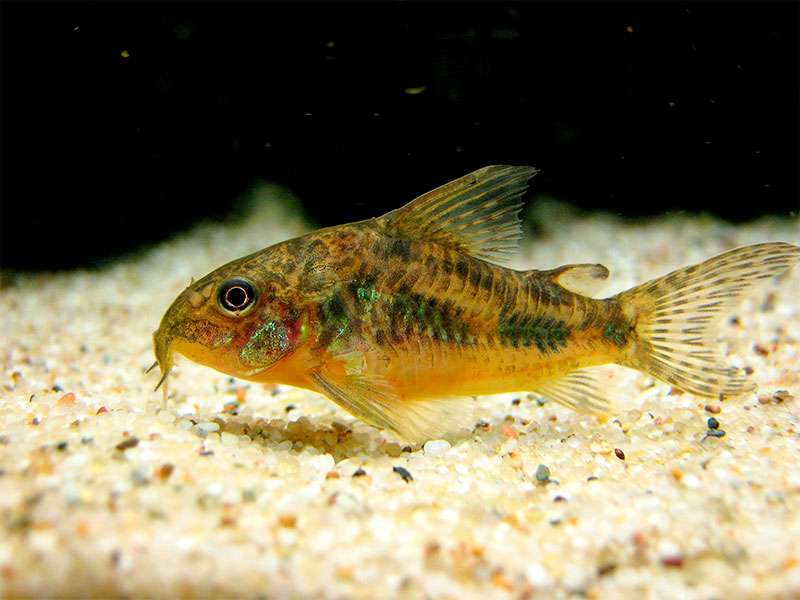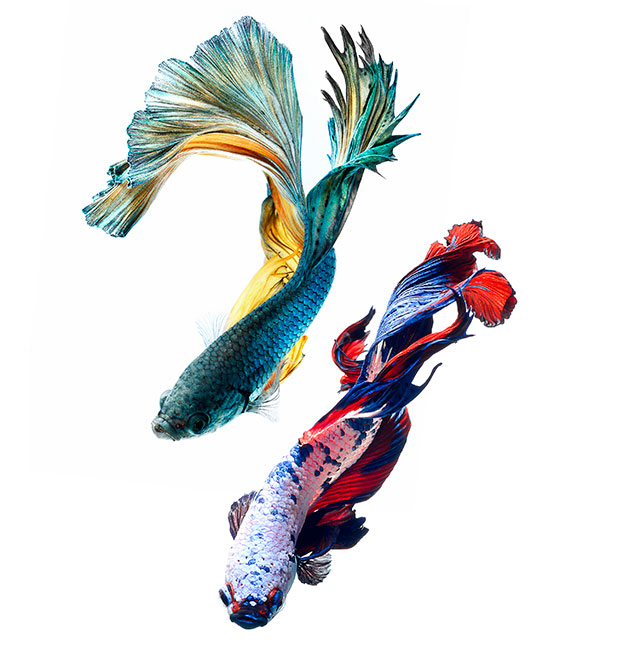In the pet store aquarist novice sees many beautiful and unusual aquatic inhabitants. Naturally, he wants to get the most spectacular of them. However, before buying you should take into account the conditions of each species - often, the more outlandish the fish, the more capricious it is in the care. Therefore, for the settlement of its first aquarium, we recommend to purchase unpretentious pets, which even a child can take care of.

Content:
The best aquarium fish for a novice of the family.
This group is one of the most popular and favorite among the owners of underwater pets. Small and undemanding, such fish are ideal for a beginner. They belong to the viviparous, so that over time you will be able to increase the number of individuals in the aquarium without any extra expenses.
Mollies

Cute and bright fishes with a large selection of interesting colors are most favorable to beginners, aquarists and forgive them many mistakes. The only exception is the selection mollies-balloon - it is better for lovers to refuse such a purchase.
Pros:
- The most survivable in their family;
- They know how to stand up for themselves in the general aquarium;
- They eat everything they give, calmly pick food from the bottom;
- Get on with most fish, except aggressive predators;
- They live from 4 to 8 years, depending on conditions.
Minuses:
- They prefer a stable temperature of water in a narrow range of +24 .. + 28 ° С;
- They require a lot of greenery and intense illumination;
- When breeding it is difficult to save offspring from eating by other fish.
If you are not sure that you will be able to provide your pet with the right care, choose a mollies of modest color - these types are more tenacious and unpretentious. Too bright breeds are artificially bred and will cause more trouble.
Guppy

The males of guppies are brightly colored, often have a voile tail. Nondescript females are slightly larger, but they need 3-4 pieces for each "boy." These calm fish are so undemanding in their care that they can even live in a three-liter jar. True, this applies only to the "purebred" guppies, and not imported.
Advantages:
- In a small aquarium of 15-30 liters up to 15 individuals can live;
- No need to spend money on lighting, filtration equipment and aeration;
- Omnivores, calmly withstand a week-long hunger strike;
- Undemanding to water temperature: they feel great at +18 and at +30 ° C;
- Get along well with other inhabitants of the aquarium;
- They breed easily, the female brings up to a hundred fry at a time.
Disadvantages:
- A relatively short life is about a year;
- Can not be kept in the same aquarium with a large aggressive fish;
- Can eat their own offspring.
Guppies give birth to fry up to 8 times in their short life, but they are not good parents. If there is no thick duckweed in the aquarium where the little ones can hide, send the “mother” into a separate jar, and after the appearance of the offspring, immediately return it to the others.
Swordtails

There are 25 varieties of these fish of the brightest color. They are larger than guppies: the female reaches 12 centimeters in length, the males are usually a little smaller. Some representatives of this species are pugnacious, therefore it is better to reduce the male population to a reasonable minimum: at least 2 females should fall on each individual.
Advantages:
- The minimum requirements for the conditions of detention: fairly normal filtration and aeration, periodic change of water every 1-2 weeks;
- Quietly tolerate short-term lowering of temperature in the aquarium to +15 ° C;
- Like all viviparous are easy to breed;
- In food unpretentious, but dry and live food is better to alternate;
- Racks to diseases, live to the age of 5 years.
Disadvantages:
- They need a larger aquarium than a guppy (at least 50 liters), while its width is very important;
- Males can fight each other if they lack females;
- They do not get along with veil fish and pluck their tails.
Remember also that the swordtails - lovers jump. To prevent fish from dying, always cover the aquarium with a lid.
The best aquarium fish for a carp beginner family
Compared with the bright color of immigrants from tropical countries - the family of the Pozilius - the carp fish have quieter and monochromatic colors. Although some specimens are quite extravagant and are able to decorate an aquarium with their presence.
gold fish

There are many variations of this fish: ranch, telescope, oranda, etc. But for a beginner, the best choice would be veils. However, they are also considered one of the most beautiful members of their family.
Advantages:
- Unpretentious in food and undemanding to water temperature, preferring more comfortable for themselves +18 ° С - the main thing is that there should not be any sharp changes;
- You can perform a partial replacement of water in the aquarium - 10-15% every week;
- They are able to last a week without food if they have eaten properly before, although they will most likely eat algae;
- With good care, live to 15 years.
Disadvantages:
- They need a large aquarium - 40-80 liters per individual;
- Prone to overeating - you need to monitor the amount of feed filled and always soak the dry mixture;
- They produce a lot of waste, which requires careful filtration of water;
- Poor transfer of the neighborhood with more aggressive "brothers", for example, comets.
Despite the diversity and beauty of goldfish, only a voilehvostov can recommend to a beginner - all other options will require the aquarist to experience and know the features of their content.
Danio

These schooling and very mobile fish are the adornment of many aquariums, but require enough space for their swims. Their color varies from crimson-red to sky-blue, the life span reaches up to 3 years. Due to the small size (about 5 cm) and the habits of living in flocks, it is better to inhabit the danios immediately in an amount of not less than 6 individuals.
Advantages:
- Do not require the creation of special conditions;
- Are omnivores;
- Feel normally at a water temperature of +16 .. + 28 ° C;
- Are inconsiderate;
- Not bad endure the first "relocation".
Disadvantages:
- They can jump out of the water, so a high cover with an air pocket of 3-4 cm in the aquarium is obligatory;
- They require space - they feel good only in wide flat containers with a minimum of tall plants;
- They love bright lighting, so you have to invest in lighting.
Despite the omnivorous, for danios it is better to buy food in the form of flakes - it is more convenient for these fish to collect food that floats on the surface.
The best aquarium fish for a novice cichlid family
They differ from other inhabitants of the aquarium not only by their beautiful coloring and forms, but also by the beginnings of intelligence, therefore it is interesting to observe them. Slow and majestic, they live to be 25 years old, are selfless parents. They are omnivorous, although this is not always a plus: cichlids eat not only dry food and algae, but they can devour smaller “neighbors” without a twinge of conscience.
Angelfish

The most popular and easily recognizable fish in any aquarium. They have long been adapted to their home conditions, and are not as capricious as previously thought. The only requirement is that the water temperature should not be below +22 ° C, otherwise the fish may get sick.
Advantages:
- Beautiful and unusual shape;
- It is easily divorced, but the cultivation of fry will require you around the clock attention;
- Angelfish themselves care about the grown offspring (if in time to save the clutch from the parents themselves).
Disadvantages:
- Because of their unusual shape and outstanding fins require a high aquarium of a large volume (at least 100 liters);
- It is necessary to maintain a stable water temperature of +24 .. + 27 ° C;
- Seen in gluttony;
- Have a very low survival rate after transportation.
Scalar is always better to buy with a margin - at least a dozen. After that, you need to trace how they break up into pairs, and distribute singles. Also, beginners should be aware that veil scalars are not suitable for a common aquarium - they will be driven even by a small fish.
Black stripes

These beautiful ornamental fish love snags and locks to hide in. They should be kept in a spacious aquarium with clean warm water - then the cichlasome will reach the optimum body length (10-17 cm) and will last for at least 10 years.
Advantages:
- Moderately large fish with a beautiful color;
- Easily adapt to changing conditions of detention;
- Easy to care for and breeding (the pair itself protects eggs and fry);
- It feeds on all types of feed, but it must be remembered that first and foremost tsikhlazomy - predators.
Disadvantages:
- They are aggressive during the spawning period, especially they dislike the bottom catfish, which attempt on caviar;
- Dig in the ground and uproot algae;
- The water in the aquarium from 100 liters must be constantly filtered, aerated and updated weekly at least by 30%.
In general, tsikhlazomy very pugnacious, but if they are kept separate from other fish, there will be no problems.
The best aquarium catfish for a beginner
These unpretentious and inconspicuous "orderlies" will greatly benefit any aquarium, picking up fallen food or the remnants of the meal of other fish. Living on the bottom, they do not compete with even the most militant "neighbors." And because of the peculiarities of their labyrinth breathing, they survive even in very dirty and muddy water.
Koridoras - speckled catfish

These fish grow in length up to 7 cm and among the aquarium catfish are considered the most mobile - it is interesting to watch them. It is preferable to have a small flock, but do not forget to provide your pets with decorative shelters.
Advantages:
- Well clean the bottom of the aquarium from fallen food;
- Very peaceful, get along with almost all neighbors;
- Not too demanding in content, they can breathe at the surface of the water - they do not need aeration at all;
- Are omnivores;
- They are simple in breeding, although it is better to separate the female to spawn in a separate aquarium.
Disadvantages:
- They love to dig and turn over the ground, stirring up the water;
- Sometimes they do not have enough food - they have to feed the bottom fish, although with modern catfish pills it is not difficult.
If you have a lot of active fish in your tank, swallowing food from the surface or on the fly, you must make a flock of corridors. They will collect from the bottom all the food that other inhabitants did not have time to grab.
Ancistrus (stuck)

Differs in its unusual mouth-sucker. This catfish does not lie at the bottom, but slides along the walls of the aquarium, devouring algae that have grown from them. Like other catfish species, ancistrus like to hide in the bottom driftwood.
Advantages:
- Survive the change in water temperature within +20 .. + 28 ° C;
- Get their own food, because they feed on plant food;
- Trouble-free breeding in the general aquarium;
- Relatively harmless to most "neighbors";
- Term life - 7 years or more.
Disadvantages:
- Sometimes they drive slow fish, especially gold ones, harming them with their suckers;
- It is impossible to colonize an aquarium with scaly inhabitants;
- They require a large “living space”, from which they feed at least 80 liters for each pair of antsistrus.
Some of these fish do not like because of the repulsive appearance. But catfish are of great benefit, so novice should not refuse to share them in the general aquarium. You also have less work with cleaning.
The best aquarium fish for a beginner family labyrinth
More than 20 species of labyrinth family of fish adapted to breathing atmospheric air.For an aquarist, this means that aeration of water is not necessary for them, but vegetation on the surface will have to be disposed of.
Cockerels

Stunningly beautiful fish with fighting inclinations, so that two males in the same aquarium can not be kept. The size of these underwater inhabitants is 6-10 cm, females are traditionally smaller and do not have such luxurious fins as their cavaliers.
Advantages:
- Feel equally well in water of any temperature from +18 to +30 ° C, but without sudden changes;
- They can live in a small aquarium;
- Have a very beautiful bright color and interesting habits;
- Eat any food;
- Term life - up to 3 years.
Disadvantages:
- Unfriendly to each other and do not get along with phlegmatic fishes;
- Prone to overeating and as a result give a large amount of waste;
- They can jump out of the aquarium.
Fry cockerel do not like sudden changes in temperature. For their purchase it is better to choose the warm season, and use a thermos for transportation.
Marble gourami

Curious moving fish with an interesting spotty color. Peace lovers to other neighbors, although occasionally even among them there are individual bullies. In a large aquarium, they grow up to 15 cm. Despite their rather large size, gourami do not know how to stand up for themselves - this must be taken into account when choosing "neighbors".
Advantages:
- Large enough and beautiful;
- Labyrinth breathing allows gouras to live in a small volume of water, although in this case they grow worse;
- They are omnivorous, but they need live food;
- With good care can live more than 7 years;
- Easy to breed.
Disadvantages:
- Get on not with all the fish, and more often they themselves are beaten;
- Prone to overeating;
- Adults require relocation to an aquarium of at least 80 liters;
- After spawning, the female should be set apart separately from the “daddy” guarding the calf, so that he does not kill her.
Make sure that each male has its own female, otherwise the fish will fight. In extreme cases, you can simply take care of natural shelters for individuals, such as thick algae plantations.
What aquarium fish for a beginner to buy
1. Did the child persuade him to buy an aquarium? First of all, start it with mollies or swordtails - it's easy to take care of them.
2. Guppies are suitable for the first experience, but only the cheapest and “purebred” - bright imported fish die more often after replanting.
3. Do you want a round classic aquarium with a minimum of inhabitants? Then buy a golden tail fish.
4. If you prefer active pets that are fun to watch, you can stop at danios.
5. In a large aquarium, which simultaneously plays the role of interior decoration, it is better to keep the chick-eye. But it is not worthwhile to add other fish to them.
6. In a small room, a tall, flat aquarium with scalars will look just as beautiful.
7. If you often leave the house for a few days or do not have time to thoroughly care for the aquarium, it is better to stop at the representatives of the labyrinth family. Gourami and cockerels will be able to live even in polluted water.
8. Whatever fish you choose, do not forget to get yourself catfish-sweepers to help you. For beginners, the corridor and the ancistrus will be the best choice.
It will be interesting to friends too







